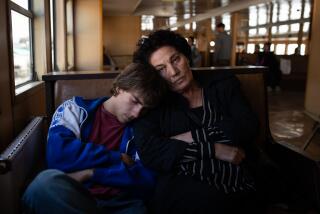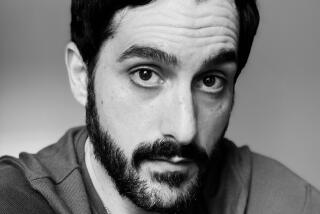Dance Review : Georgian State Dancers Open at San Diego Festival
- Share via
SAN DIEGO — What comes to mind when you think of Russian folk dancing? Ballet and Broadway’s strapping fellows in tunics and boots, arms folded across their chests, doing squat-kicks and knocking back the vodka?
Maybe it’s Innocent Ivan and his two brothers at Aurora’s Wedding in Marius Petipa’s choreography for “The Sleeping Beauty,” or the cossacks at the local tavern in Jerome Robbins’ “Fiddler on the Roof.”
Well, that kind of saltation pales next to the leaping, sword play and male pointe dancing (without block shoes, no less) of the Georgian State National Singing and Dancing Ensemble, which opened at the Spreckels Theatre on Wednesday for a five-day run as the key dance entry in San Diego’s predominately Georgian and Russian “Treasures of the Soviet Union” arts festival.
Yet astounding as the feats of these Georgians were, much of the program was spent on unremarkable group formation dancing that downplayed the male dancers’ abilities and used the women only as decoration.
Like Garrison Keillor’s Lake Wobegon, their Georgia is a place where all the men are strong, all the women are beautiful and all the children (if there were any) would be above average. Stone Age patriarchy rules the roost, with the men cavorting and battling one another, while the women skirr silently and expressionlessly across the floor, demurely lowering their eyes in the presence of the opposite sex.
In fact, that’s all the 10 women of the troupe ever do. And while their gliding is ornate, propelled by itty-bitty steps hidden by floor-length gowns, it can’t compete with the flashy male athletics. The women are primarily accessories for the men and even in the pair dances, the women and men don’t touch each other.
When the men take the floor alone, however, they forbid inattention, bounding in from the wings, twisting, turning, diving to their knees and whipping around on the ground like dervishes.
In the show’s opener, the “Khandjluri,” the warriors threw daggers into the stage floor and danced around them. Later, in a Highland saber-and-shield dance called the “Paricaoba,” sparks flew as pairs of dancers combined pirouettes with sword fighting.
Only in the finale, “Mkheduli,” did we really see what the men could do. Leaps, pointe dancing, turns and staccato movements were combined to suggest cavalrymen and horses in battle.
The well-rehearsed 16-member choir, conducted by artistic director Jemal Chkuaseli, sung several a cappella hymns and labor songs ranging from dirgelike to spritely and dating back as far as the 10th Century. Rich and robust tones came forth from faces that were often beguilingly melodramatic.
A standing ovation encouraged several of the leading male dancers to fly into the air, whir and prance on pointe with even more vivacity than before.
More to Read
The biggest entertainment stories
Get our big stories about Hollywood, film, television, music, arts, culture and more right in your inbox as soon as they publish.
You may occasionally receive promotional content from the Los Angeles Times.










